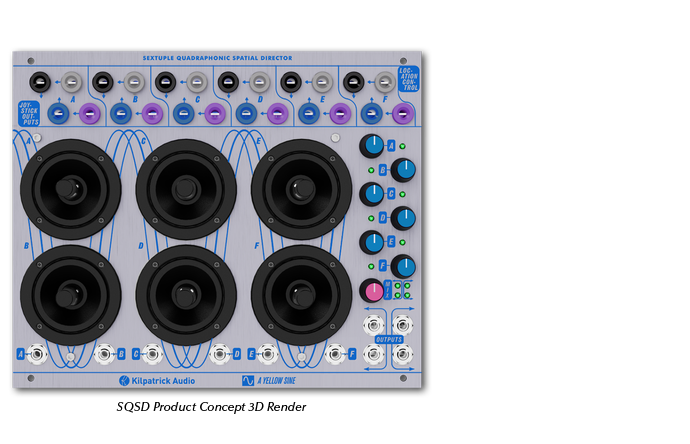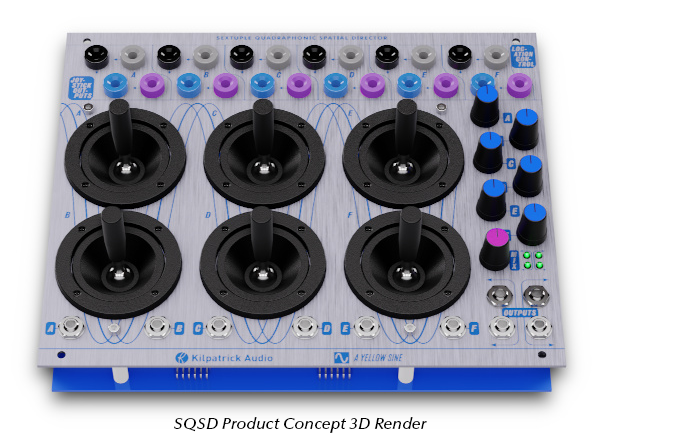A Yellow Sine Electronic musical instruments
Sextuple Quadraphonic Spatial Director
Fully analog "West Coast-format" performance-oriented joystick controller and quadraphonic panning mixer
The SQSD combines six joysticks capable of generating control voltage with a six-input equal panning mixer, allowing for intuitive and fun direction of spatial sound in both stereo and quadraphonic speaker configurations.
Each of the six joysticks generate two control voltage signals: one for each axis of motion. These CV outputs can modulate parameters on compatible voltage-controlled electronic music equipment. A Banana to Minijack Adapter kit is available to connect the SQSD to 3.5mm control voltage destination or sources. Using the joysticks to control the location of a sound source is intuitive and fun, and the SQSD makes this easy by incorporating six channels of quadraphonic panning.
Quadraphonic sound involves the use of four speakers to create an immersive listening experience in which sounds can move around the listener, from front to back, side to side and everywhere in between. It’s the most accessible form of what’s called spatial or surround sound since it only requires four speakers.
Two dedicated location control inputs are available for each of the six channels. You can connect control voltage signals from a sequencer, envelope or LFO to these inputs, but the joysticks are a nice, natural fit. If you want to move a sound to the rear left-side, just move the joystick to the rear-left side. Want to make a sound rotate around the room? Just rotate the joystick and the sound will follow.
The twelve joystick CV outputs and location control inputs are grouped together, and can be easily patched with shorting bars. Convenient DIP switches on the back of the unit normalize these connections without the need for any patching.
DIP switches also allow for the selection of either 0 to 10V or -5V to +5V CV ranges for the location control inputs.
Stereo panning is also possible. For that use case, you'd only need the horizontal joystick signals, connecting purple outputs to grey inputs at the top. The resulting stereo signals would be available from the bottom pair of mixer outputs.
The last part of the SQSD is the mixer section. Up to six channels of sound can become part of the quadraphonic or stereo spatial direction, with each channel having its own dedicated level control and LED indicator light. There’s a main mix output control as well with LEDs for each of the four outputs too. If you want you can use the SQSD as a normal six-channel mixer - plug in your sound sources, remove any connections to the location control inputs and the mixer knobs will allow you to adjust the levels which will be combined at the bottom left output jack.
While the SQSD can integrate seamlessly with an existing "West Coast-format" setup, we are also pleased to be able to offer a self-contained, powered enclosure option. This allows for quadraphonic panning right out of the box, with no additional hardware required. This highly portable option may appeal to existing modular users, as case-mounted joysticks are rarely positioned ergonomically. Please note that the powered enclosure is not available for sale separately.
The SQSD is now available for pre-order. The cost is $1,750 USD or $2,250 USD with the custom-made, powered enclosure. Worldwide shipping is available. You can pre-order the SQSD here. If you have any questions, don't hesitate to reach out.

Director's Notes
The stackable nature of banana cables means that a single joystick can perform many actions. By patching the outputs from one to the location controls of several channels, a single joystick can spatialize multiple sound sources. Connecting a joystick output to both the location control input and some other parameter in your system can create a linking of the sound's movement with another of its features.
One example of this is to send the vertical axis of a joystick to both the location control and the mix control of a reverb effect. When the sound moves away from one end of the room it becomes more reverberated. You could additionally use an inverted version of this control voltage signal to control the frequency cutoff of a lowpass filter, so as the sound source moves away it contains less frequency content as well, which combined with the increase in reverb amount would simulate natural acoustic properties of distance.
A simple stereo setup where the horizontal axis controls panning and the vertical axis controls amplitude or volume is quite intuitive. The horizontal axis might control the index or amount of frequency modulation applied to an oscillator, while the vertical axis controls the frequency of the modulating oscillator.
The four outputs of the SQSD don't necessarily have to connect to speakers either. Using the joysticks to crossfade different sound source inputs allows for complex signal blending. A patch with just four oscillators signals and two control voltage inverters will allow the SQSD to use the principles of vector synthesis, uniquely providing simultaneous access to four different waveform blends at the output mixer.
Specifications
- "West Coast-format" (4U) two space module
- Low-noise CV and audio signal path
- No digital circuitry used - 100% analog design!
- Six channel quadraphonic mixer with voltage control
- Six joysticks with X and Y outputs: 0-10V = L>R, 0-10V = S>F
- Six quadraphonic constant-power directional panners with voltage control
- Internal normalling switches to connect joysticks to directional panners
- Directional panners can accept -5V to +5V or 0-10V (DIP switch selectable)
- Audio inputs support >10Vpk (>20dBu) max input level
- Audio inputs have 0dB/+10dB selectable gain (DIP switch selectable)
- Audio outputs support >10Vpk (>20dBu) max output level
- Audio input and output signal level indicators (-16dB min. indication)
- Audio jacks available with Switchcraft 3.5mm minijack or Tini jacks
- Banana jacks use Johnson / Cinch banana connectors
- High-quality brushed anodized aluminum panel
- Requires +15V at 425mA and -15V at 375mA
- Dimensions: 8.5" x 7" x 1.9" max depth
- Warranty: 1 year
- Completely designed, assembled and tested in Canada
- Optional: 2HP powered enclosure available with module fitted

Inspiration
I've been serious about composing and performing for multichannel speaker arrangements for a number of years now, so naturally when planning a modular instrument quadraphonic performance considerations are at the forefront. When composing with multiple sound sources, the amount of hardware necessary for individual spatialisation starts to become unwieldy very quickly. I considered several propositions for a scalable solution. For n sound sources, I would need to purchase n dedicated joystick control modules, and while there are manufacturers that incorporate panning into their joystick modules, I would also need four mixers with n inputs each, so that the front left, front right, surround left and surround right signals from each of the joystick / panning modules could be mixed together before going to the four speakers. The cost and size really started to add up quickly, and it wasn't a very scalable solution.
Another option I explored was 'in-the-box' panning, where my sound signals would be sent to my DAW through an interface and spatialized using software, and then output as four quadraphonic signals. While this solves the space problem in many ways, interfaces which can accomodate all those inputs can get quite costly, and moving signals in realtime around a quadraphonic space with software isn't very satisfying. I considered building a joystick-based MIDI controller, which brings the tactile experience back, but also further increases the dependency on software and introduces latency.
The more I thought about it, the more I felt the best solution was a compact instrument with plenty of joystick controls which could handle all those inputs and outputs internally. I spoke with my good friend Andrew at Kilpatrick Audio about this problem and we began brainstorming together about how it could be done. While a digital solution would certainly work, I issued the challenge to Andrew to see if this was something that could be built in analog. With the ongoing parts shortage critically affecting modular instrument designers the world over, this was the right time to try something that didn't depend on unsourceable parts and backordered microcontrollers.
Andrew's fierce dedication and profound electronic circuit design knowledge was put to the test, but when this monster of a module was completed it was everything I'd hoped it would be and more. Andrew and I share the philosophy that if a product is useful to us, chances are it will be useful to someone else, and that's why we're so pleased to be able to bring the flexibility and performance-focus of the Sextuple Quadraphonic Spatial Director to you.
-Pat McMaster, November 2021